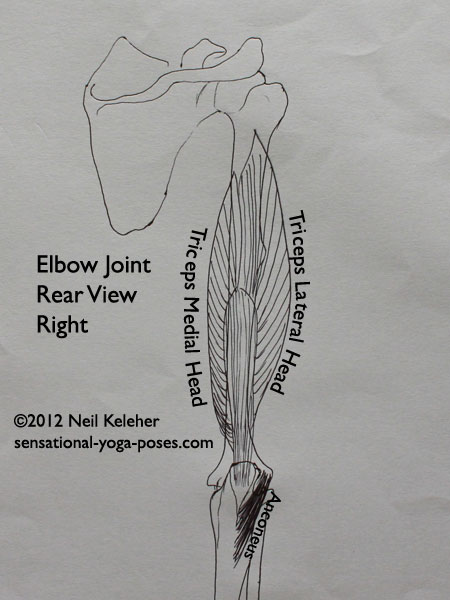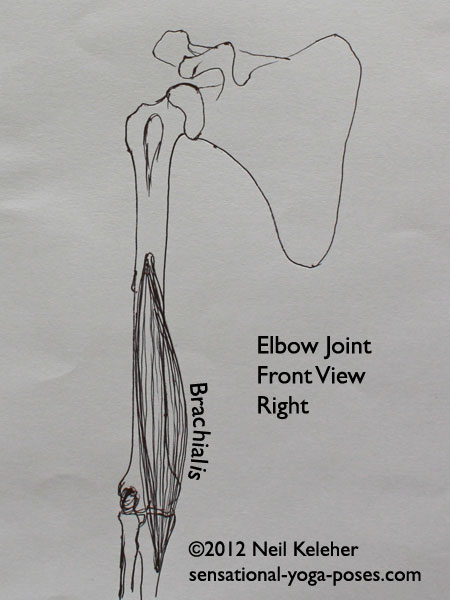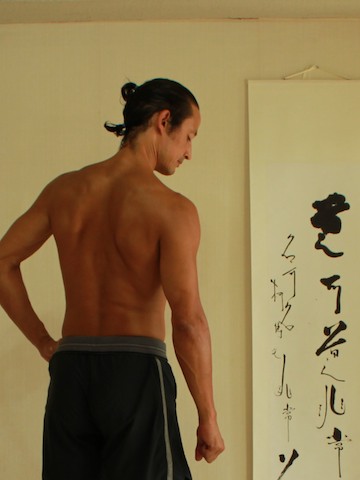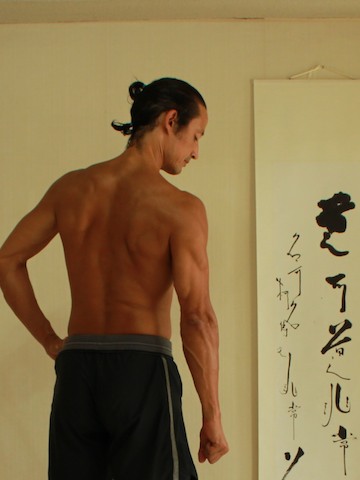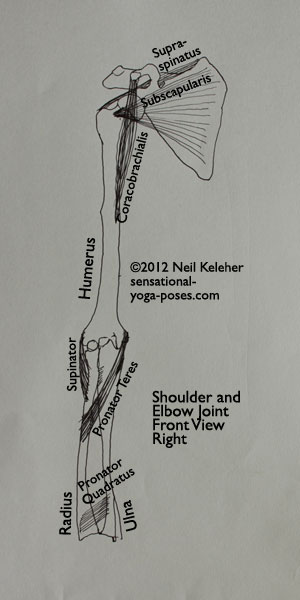Single Joint Muscles that Act Between Humerus and Ulna
The Brachialis is a single joint muscle that crosses the front of the elbow. It can be used to bend the elbow.
The lateral and medial heads of the Triceps cross the back of the elbow. They can be used to straighten the elbow.
All of these muscles attach to the ulna (and not the radius).
Used against each other these two sets of muscle can be used to stabilize the elbow whether it is straight or bent.
Straightening the Elbow
You may have heard or read instructions about keeping a micro bend in the elbow or knee so that either joint is safe.
For some people the tendency is straighten the elbow and then keep it straight without any muscle action. The result is that bone presses against bone.
Microbending is a way of avoiding this situation.
Another option is to engage the single joint elbow muscles at the front and back of the elbow joint at the same time.
You can do this with a straight (locked) elbow, or with a slight microbend or with the elbow bent any amount.
The advantages of doing this may be more than just a stronger (and more stable) elbow joint.
"Squeezing" the elbow (both front and back) may affect the muscles of the shoulder joint, in particular the rotator cuff muscles and other single joint muscles of the shoulder. The connective tissue that contains the single joint muscles of the elbow is continuous in most (if not all) cases with the connective tissue that contains the single joint muscles of the shoulder.
This same connective tissue in some cases is also continuous with the muscles that stabilize the shoulder blade with respect to the rib cage.
Because of this, muscle tension in the muscles of the elbow can add tension that helps the muscles of the shoulder.
Isolating Single Joint Muscles of the Elbow
The single joint muscles of the elbow joint are relatively easy to activate, particularly if you've already got some shoulder awareness.
With elbow straight, squeeze or engage the muscles at the back of the arm. This is to engage the triceps. But to avoid activating the long head of the triceps keep the back of the shoulder relaxed.
If you squeeze just below the back of the elbow you'll also be activating anconeus.
Also engage the muscles at the front of the arm just above the elbow as if trying to bend the elbow. The two sets of muscles then work against each other to make the elbow stable.
Another way to activate both sets of muscles simultaneously is to focus on making the elbow feel straight. Then make it feel straighter. Once the elbow is straight, it's straight, but you can continue to add tension to the front and back of the elbow to give a sensation of making the elbow feel straighter.
Try the same thing with elbow joint partially bent. Make the front and back of the elbow feel strong. But focus the "strength" to the area around the elbow joint.
Then try the same thing while varying the muscle tension so that your elbows "turn." It's actually not your elbows turning, but your upper arm and forearms. But the turning movement can be generated by muscles that cross the front of the elbow and attach to the radius. (The triceps, anconeus and brachialis all attach from the humerus to the ulna.)
For myself I did this exercise to train an inactive triceps head. To that end after practicing with each arm individually I then focused on engaging both elbows and making the muscles of both arms feel the same, particularly the triceps medial and triceps lateral head.
(In the first picture, triceps are relaxed. In the second picture they are engaged.)
Elbow Single Joint Muscles
Single joint elbow muscle at the back of the arm are:
- triceps medial head
- triceps lateral (outer) head
- anconeus
At the front of the arm they are:
- brachialis
- pronator teres
- supinator
- brachioradialis
One of the interesting things about the elbow joint is that it is the meeting place of three bones, the upper arm bone (humerus) and two lower arm bones, radius and ulna. When the elbow bends and straightens the ulna is moving relative to the humerus. Turning of the wrist and forearm happens between the radius and the ulna.
So now I should refine single joint elbow muscles to include only those muscles that act between ulna and humerus.
Those are:
- triceps medial and lateral heads
- anconeus
- brachialis
Benefits of Learning to Isolate Elbow Joint Muscles.
In elbow joint anatomy, and any other yoga anatomy related discussions, the purpose for isolating and learning to contract particular muscles is so that you can better use them in the context of a yoga pose.
An equivalent would be learning the letters of the alphabet. Once you've learned the letters you don't keep practicing them because you practice them in the context of the words you use. Likewise with elbow anatomy and the muscles of the elbow joint.
Once you've learned to isolate the single joint elbow muscles you may then find it easier to use them so that they play an integrated role with muscles of the shoulder (and wrists) and other parts of the body.
They can also be used to affect muscles of other joints via fascial meridian connections.
Using Thomas Myers Anatomy trains as a reference, the brachioradialis is part of the Deep Front Arm Line Myofascial meridian. Via this meridian it connects to biceps brachii, coracobrachialis, and the pectoralis minor muscle. For this reason, it can be quite difficult to completely isolate the single joint muscles at the front of the elbow.
For myself, even though I try to activate only brachialis, I feel like biceps brachii also slightly contracts.
The triceps is part of the Deep Back Arm Line. This meridian connects with the rotator cuff muscles, rhomboids and levator scapulae. It's via these connection at the front and back of the elbow that the single joint elbow muscles can affect the shoulders.
Rotating the Forearm
Another set of elbow joint muscles work on the relationship between the radius and the ulna. These two bones make up the forearm.
The radius can turn or twist around the ulna. These two actions are called
- supination (which is external rotation) and
- pronation which is internal rotation.
Supination and Pronation
If you position your forearm so that your pinky side of your palm faces in the same direction as the point of your elbow, supination, or external rotation is turning your forearm so that your palm faces in the opposite direction to your elbow.
Pronation or internal rotation is turning your forearm so that palm faces in the same direction as the point of your elbow.
As with the single joint muscles in general, the supinator and pronators can be used against each other to stabilize the forearm.
The pronator teres and supinator are both located close to the elbow joint. Because of this proximity you may find that you these muscles also activate when you activate brachialis and triceps.
For myself, when I first practiced "squeezing" my elbows, I found it very easy to do strong or muscular rotational movements of my forearm. Then I found that I could relax my pronators and supinators and focus just on stabilizing ulna relative to humerus.
One of the main reasons for discussing the pronators and supinators of the elbow joint is that these muscles can be used in place of the shoulder muscles to rotate the arm.
This can have applications in yoga poses where the arms are free. But it may have more relevance when they are bearing weight.
Controlling the Elbow Joint in Down Dog (And Perhaps Even Handstand)
In yoga poses like downward dog where your hands are on the floor, any movement of the forearms (either supination or pronation) rotates the upper arm at the shoulder joint. You could use your pronators and supinators to drive this action. Or you could use the muscles of your shoulders to do this action.
In this case it may be the muscles of your rotator cuff doing the rotation, particularly infraspinatus, subscapularis and teres minor, though teres major may also take part in the action.
Personally whenever I do yoga poses like down dog or even handstand, I hardly ever used to pay attention to the orientation of my elbows. My main concern, especially lately, has been to spread my shoulder blades and move them away from my waist. The effect is that I push my ribcage and pelvis back away from my hands.
While I have talked about stabilizing the shoulder joints in postures like handstand where the shoulders bear all of the body's weight, I don't actually do it all the time. I always thought that if the shoulder blades are stable the rotator cuff muscles can take care of themselves.
Focusing on the elbow joint, I found that activating the single joint muscles to stabilize the ulna/humerus joint gave a different feel to the pose. With elbows strong it felt right to simply focus on reaching my ribcage away from my hands without worrying about whether shoulder blades are spread or not.
It's another tool that I get to play with when doing "weighted arm" yoga poses.
Transmitting Tension Via Polyarticulate Arm Muscles
I think that part of the reason that these elbow joint muscles affect the shoulders is because of the biceps brachii and triceps long head. Both of these muscles attach between the bones of the forearm and the scapulae. By adjusting the twist of the forearms, tension is varied in these two muscles, which can shift the position of the scapulae relative to the upper arms.
I've also mentioned the anatomy trains that run up the front and back of the arms. Since the elbow joint muscles are a part of these trains, as are the shoulder muscles and rotator cuff muscles, tension in the elbow muscles affects the shoulder muscles.
I haven't got enough experience as of yet to say how you should activate your elbow muscles when doing down dog or handstand. But what I can say is that it may be worth your while to practice activating these muscles in isolation so that you can then self experiment in down dog or even cat pose, to notice how activating the mono-articular muscles of the elbow joint can affect the shoulders.
Published: 2012 08 01
Updated: 2019 11 30
